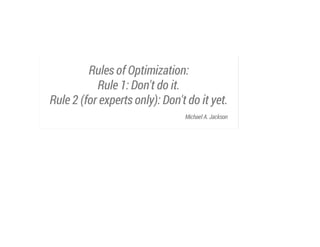Ad
Clean android code
- 1. Clean Android Code Fabio Collini GDG Firenze - 13 Febbraio 2014
- 3. Agenda Definizione di Clean Code Formattazione del codice Clean code vs optimization Best practices Java Gestione delle risorse Android Test
- 4. "The only way to make the deadline -- the only way to go fast -- is to keep the code as clean as possible at all times." Clean code - Robert C. Martin
- 5. Definizione di Clean Code Leggibile Manutenibile Espandibile Espressivo Corretto Testabile ...
- 8. Eclipse
- 9. Android Studio / IntelliJ
- 11. android.view.View itmrvtFas n Piaelg; /.. /. pbi vi stsotaepc(ola iRo){ ulc od eIRoNmsaeboen sot i (sot { f iRo) mrvtFas| I_OTNMSAE Piaelg = SRO_AEPC; }es { le mrvtFas& ~SRO_AEPC; Piaelg = I_OTNMSAE } } pbi boeniRoNmsae){ ulc ola sotaepc( rtr (Piaelg&SRO_AEPC)! 0 eun mrvtFasI_OTNMSAE = ; }
- 12. Ottimizzazione del codice la classe View è istanziata molte volte all'interno di ogni activity di ogni app ha senso ottimizzare l'occupazione di memoria ma nel codice di una app?
- 13. Rules of Optimization: Rule 1: Don't do it. Rule 2 (for experts only): Don't do it yet. Michael A. Jackson
- 14. Enum storicamente su Android erano sconsigliate con il JIT compiler la situazione è migliorata
- 15. Per evitare creazione di oggetti gli int sono molto usati Tutte le risorse sono int nella classe R txVe.eTx(0) etiwstet10; Cue b:adodcnetrsRsucsNtonEcpin asd y nri.otn.e.eore$oFudxeto: Srn rsuc I #x4 tig eore D 06 a adodcnetrsRsucsgtetRsucsjv:3) t nri.otn.e.eore.eTx(eore.aa29 a adodwde.etiwstetTxVe.aa34) t nri.igtTxVe.eTx(etiwjv:84 txVe.eTx(nee.otig10) etiwstetItgrtSrn(0);
- 17. SimpleCursorTreeAdapter nwSmlCroTeAatrti,gopusr e ipeusrredpe(hs ruCro, adodRlyu.ipeepnal_itie_, nri..aotsml_xadbels_tm2 nwSrn[{Clm1,"oun", e tig]"oun" Clm2} nwit]adodRi.et,adodRi.et} e n[{nri..dtx1 nri..dtx2, adodRlyu.ipels_tm1 nri..aotsml_itie_, nwSrn[{Clm3,"oun", e tig]"oun" Clm4} nwit]adodRi.et,adodRi.et} { e n[{nri..dtx1 nri..dtx2) /.. /. } ;
- 20. The first time you do something, you just do it. The second time you do something similar, you wince at the duplication, but you do the duplicate thing anyway. The third time you do something similar, you refactor. Martin Fowler
- 23. Activity classe base da usare per creare una interfaccia grafica nei casi semplici contengono tutto possono diventare molto grandi e difficili da gestire
- 24. Fragment interfacce responsive ciclo di vita complicato utili ma non semplici da usare
- 25. Custom View classi che estendono una View possono essere usate in un layout usate per creare componenti nuovi utili anche per raggruppare codice
- 26. ButterKnife injection delle view in una classe basato su annotation processing semplice da usare rende il codice più leggibile
- 27. Flow e Mortar framework sviluppati da Square basati su Dagger sostitutivi ai fragment, semplificano il ciclo di vita
- 28. Risorse in un progetto Android
- 33. <eore> rsucs <tl nm=lyuSye> sye ae"aottl" <tmnm=adodlyu_it"mthprn<ie> ie ae"nri:aotwdh>ac_aet/tm <tmnm=adodlyu_egt>ac_aet/tm ie ae"nri:aothih"mthprn<ie> <tmnm=adodoinain>etcl/tm ie ae"nri:retto"vria<ie> <tmnm=adodgaiy>etr/tm ie ae"nri:rvt"cne<ie> <sye /tl> <tl nm=txVeClr> sye ae"etiwoo" <tmnm=adodtxSz"10p/tm ie ae"nri:etie>5s<ie> <tmnm=adodtxClr>555<ie> ie ae"nri:etoo"#111/tm <tmnm=adodlyu_it"wa_otn<ie> ie ae"nri:aotwdh>rpcnet/tm <tmnm=adodlyu_egt>rpcnet/tm ie ae"nri:aothih"wa_otn<ie> <sye /tl> <rsucs /eore>
- 35. <eore> rsucs <tl nm=lyuSye prn=lyuSyeae> sye ae"aottl" aet"aottlBs" <tmnm=adodoinain>oiotl/tm ie ae"nri:retto"hrzna<ie> <sye /tl> <rsucs /eore>
- 36. <eore> rsucs <oo nm=txClr>555<clr clr ae"etoo"#111/oo> <rsucs /eore> <eore> rsucs <ie nm=txSz"10p/ie> dmn ae"etie>5s<dmn <rsucs /eore> <eore> rsucs <ie nm=txSz"20p/ie> dmn ae"etie>5s<dmn <rsucs /eore>
- 37. Include di layout equivalente di un extract method utile quando una piccola parte del layout cambia in base alla configurazione
- 38. Tipi di risorse disponibili Layout Drawable Stili String Animazioni Color Color state list Boolean Dimension Id Integer Array
- 39. Il codice Java dovrebbe essere indipendente dalle configurazioni
- 40. Test Coperto da test Vs Testabile L'architettura dell'app è fondamentale per avere codice testabile
- 41. Dagger A fast dependency injector for Android and Java
- 42. Dagger Object: possono essere singleton Module: classi Java che creano Object ObjectGraph: creato runtime a partire da più moduli
- 43. Scope pbi OjcGahpu(bet. mdls { ulc betrp lsOjc.. oue) } Permette di creare oggetti legati a scope: Application Activity Fragment
- 47. Pro di Dagger alto disaccoppiamento delle classi validazione compile time delle dipendenze moduli di test con stub e mock
- 48. EventBus permette di usare una architettura basata su eventi usando il metodo p s vengono invocati i metodi ot oEet n v n degli oggetti che si sono registrati con rgse eitr simile a Otto ma non basato su annotation gestisce anche i thread in background
- 49. Uso di EventBus Gerarchia di eventi: listener su classi base Gli eventi possono essere Parcelable Ciclo di vita Activity/cambio di orientation
- 51. Test Driven Development pbi vi tsCluao( { ulc od etacltr) asrEul(,cluao.u(,2) setqas4 acltrsm2 ); }
- 52. FEST Android pbi vi tsU( { ulc od eti) asrTa(aot.siil( sethtlyu)iVsbe) .setcl) iVria( .aCidon() hshlCut4 .aSoDvdr(HWDVDR_IDE; hshwiiesSO_IIESMDL) }
- 53. Quello che servirebbe... pbi vi tsU( { ulc od eti) asrEul(aot mcu) setqaslyu, okp; }
- 54. Test della ui utili per creare il caso di test aggiungendo uno wait è possibile interagire con il device Spoon permette di eseguire i test su più device e salvare screenshot
- 55. Java 8 in uscita a Marzo lambda expression e molte altre novità cambierà il modo di scrivere codice
- 56. Riferimenti Robert C. Martin - Clean code Martin Fowler - Refactoring: Improving the Design of Existing Code Simpler Android apps with Flow and Mortar github.com/JakeWharton/butterknife github.com/square/dagger github.com/greenrobot/EventBus github.com/square/fest-android
- 57. Thanks for your attention! Questions? @fabioCollini linkedin.com/in/fabiocollini
















![SimpleCursorTreeAdapter
Context
Cursor
int
String[]
int[]
int
String[]
int[]](https://image.slidesharecdn.com/cleanandroidcode-gdgfirenze-140216041501-phpapp02/85/Clean-android-code-16-320.jpg)
![SimpleCursorTreeAdapter
nwSmlCroTeAatrti,gopusr
e ipeusrredpe(hs ruCro,
adodRlyu.ipeepnal_itie_,
nri..aotsml_xadbels_tm2
nwSrn[{Clm1,"oun",
e tig]"oun" Clm2}
nwit]adodRi.et,adodRi.et}
e n[{nri..dtx1 nri..dtx2,
adodRlyu.ipels_tm1
nri..aotsml_itie_,
nwSrn[{Clm3,"oun",
e tig]"oun" Clm4}
nwit]adodRi.et,adodRi.et} {
e n[{nri..dtx1 nri..dtx2)
/..
/.
}
;](https://image.slidesharecdn.com/cleanandroidcode-gdgfirenze-140216041501-phpapp02/85/Clean-android-code-17-320.jpg)
![Usando classi/enum
Context
Cursor
Layout
Column[]
ViewId[]
Layout
Column[]
ViewId[]
Context
Cursor
LayoutColumnMapping
LayoutColumnMapping](https://image.slidesharecdn.com/cleanandroidcode-gdgfirenze-140216041501-phpapp02/85/Clean-android-code-18-320.jpg)





















































































